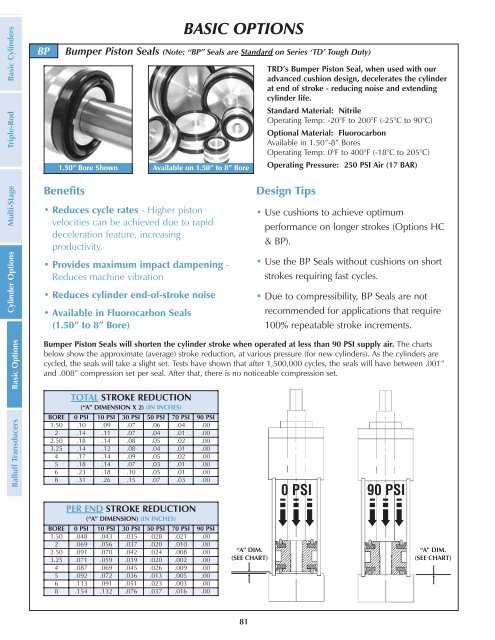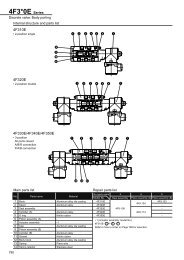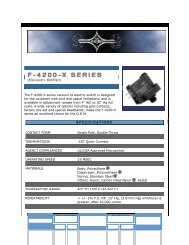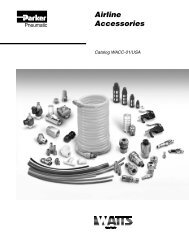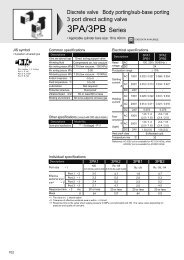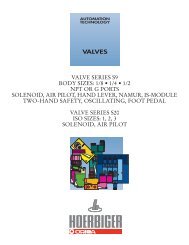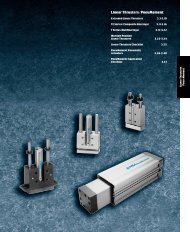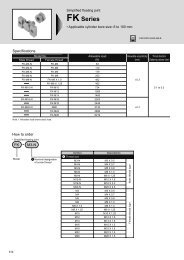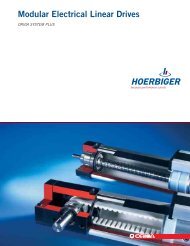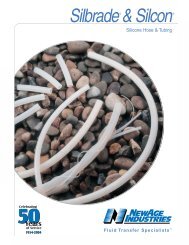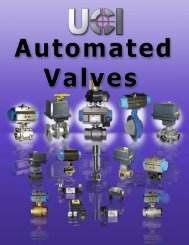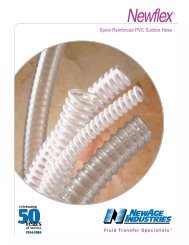The items listed below are all included in TRD's ... - Fluidraulics Inc
The items listed below are all included in TRD's ... - Fluidraulics Inc
The items listed below are all included in TRD's ... - Fluidraulics Inc
Create successful ePaper yourself
Turn your PDF publications into a flip-book with our unique Google optimized e-Paper software.
Basic Cyl<strong>in</strong>ders<br />
Triple-Rod<br />
Multi-Stage<br />
Cyl<strong>in</strong>der Options<br />
Basic Options<br />
B<strong>all</strong>uff Transducers<br />
BASIC OPTIONS<br />
BP Bumper Piston Seals (Note: “BP” Seals <strong>are</strong> Standard on Series ‘TD’ Tough Duty)<br />
1.50” Bore Shown Available on 1.50” to 8” Bore<br />
Benefits<br />
• Reduces cycle rates - Higher piston<br />
velocities can be achieved due to rapid<br />
deceleration feature, <strong>in</strong>creas<strong>in</strong>g<br />
productivity.<br />
• Provides maximum impact dampen<strong>in</strong>g -<br />
Reduces mach<strong>in</strong>e vibration<br />
• Reduces cyl<strong>in</strong>der end-of-stroke noise<br />
• Available <strong>in</strong> Fluorocarbon Seals<br />
(1.50” to 8” Bore)<br />
81<br />
TRD’s Bumper Piston Seal, when used with our<br />
advanced cushion design, decelerates the cyl<strong>in</strong>der<br />
at end of stroke - reduc<strong>in</strong>g noise and extend<strong>in</strong>g<br />
cyl<strong>in</strong>der life.<br />
Standard Material: Nitrile<br />
Operat<strong>in</strong>g Temp: -20°F to 200°F (-25°C to 90°C)<br />
Optional Material: Fluorocarbon<br />
Available <strong>in</strong> 1.50”-8” Bores<br />
Operat<strong>in</strong>g Temp: 0°F to 400°F (-18°C to 205°C)<br />
Operat<strong>in</strong>g Pressure: 250 PSI Air (17 BAR)<br />
Design Tips<br />
• Use cushions to achieve optimum<br />
performance on longer strokes (Options HC<br />
& BP).<br />
• Use the BP Seals without cushions on short<br />
strokes requir<strong>in</strong>g fast cycles.<br />
• Due to compressibility, BP Seals <strong>are</strong> not<br />
recommended for applications that require<br />
100% repeatable stroke <strong>in</strong>crements.<br />
Bumper Piston Seals will shorten the cyl<strong>in</strong>der stroke when operated at less than 90 PSI supply air. <strong>The</strong> charts<br />
<strong>below</strong> show the approximate (average) stroke reduction, at various pressure (for new cyl<strong>in</strong>ders). As the cyl<strong>in</strong>ders <strong>are</strong><br />
cycled, the seals will take a slight set. Tests have shown that after 1,500,000 cycles, the seals will have between .001”<br />
and .008” compression set per seal. After that, there is no noticeable compression set.<br />
TOTAL STROKE REDUCTION<br />
(“A” DIMENSION X 2) (IN INCHES)<br />
BORE 0 PSI 10 PSI 30 PSI 50 PSI 70 PSI 90 PSI<br />
1.50 .10 .09 .07 .06 .04 .00<br />
2 .14 .11 .07 .04 .01 .00<br />
2.50 .18 .14 .08 .05 .02 .00<br />
3.25 .14 .12 .08 .04 .01 .00<br />
4 .17 .14 .09 .05 .02 .00<br />
5 .18 .14 .07 .03 .01 .00<br />
6 .23 .18 .10 .05 .01 .00<br />
8 .31 .26 .15 .07 .03 .00<br />
PER END STROKE REDUCTION<br />
(“A” DIMENSION) (IN INCHES)<br />
BORE 0 PSI 10 PSI 30 PSI 50 PSI 70 PSI 90 PSI<br />
1.50 .048 .043 .035 .028 .021 .00<br />
2 .069 .056 .037 .020 .010 .00<br />
2.50 .091 .070 .042 .024 .008 .00<br />
3.25 .071 .059 .039 .020 .002 .00<br />
4 .087 .069 .045 .026 .009 .00<br />
5 .092 .072 .036 .013 .005 .00<br />
6 .113 .091 .051 .023 .003 .00<br />
8 .154 .132 .076 .037 .016 .00


